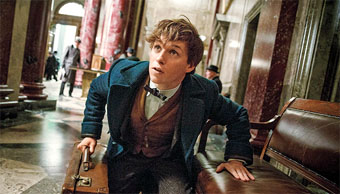
Image courtesy of Warner Brothers
Fantastic Beasts and Where to
Find Them
| published December 2, 2016 |
By Cameron Dale, Thursday Review contributor
I know I have written this before: special effects technologies have become so impressive that they have taken on a life of their own, often driving the development of movies, some good, some fair-to-middling, some lousy.
Doctor Strange, in the works and under some form of development for decades, finally arrived at the production stage at the right moment in movie tech—meaning that the story’s ample imaginings and complex handling of super powers and sorcery cab be executed with wonderful visual skill. Mattel’s Max Steel, on the other hand, shows that technology can only go so far; that movie was a unmitigated dud, and an example of how digital effects cannot close the gap when the rest of the elements are missing: good storytelling, narrative power, acting, editing all matter.
Based on the works of J.K. Rowling, author of a slew of famous Harry Potter tales of sorcery, wizardry and magic, Fantastic Beasts and Where to Find Them—starring Eddie Redmayne as Newt Scamander—merges great storytelling with digital special effects with magical (pun intended) results on the screen. This movie, directed by David Yates (who directed numerous Harry Potter adventures), is definitely worth seeing at the theater where the lavish sound effects, sumptuous music, and visual smorgasbord can be best enjoyed by viewers of all ages.
Short version without spoiling anything: a classic tale of travel adventure, our wide-eyed young Newt—a part time writer—arrives from England to New York City in the 1920s. He carries a small brown suitcase, inside of which he has stashed an entire galaxy of weird creatures, otherworldly blobs, quasi-alien thingamabobs, tiny sprites and spritzes, and semi-horrific monsters. Newt alone can open the satchel, otherwise mayhem will result. This sets us up for a predictable scenario since we just KNOW someone unauthorized will pop open the case. There is a mishap in which the little luggage will be switched, and soon thereafter Newt finds himself in trouble for his wizardry.
Like the steamer trunk on The Cat in the Hat (which opens up a whole second set of dimensions) or the modern “containment unit” of the Ghostbusters of New York City, all hell breaks loose, sort of literally, when the creatures are unleashed.
The oft-asked question is this: is Fantastic Beasts connected in any way to the world of Harry Potter. There is no easy answer, but generally one can think of this story as running more-or-less parallel to Potter’s world—it is neither sequel nor prequel. Unlike Potter and his friends, who are wizards-in-training, Newt is the real deal, card-carrying and sanctioned. But there are lots of overlaps between the stories of Harry and those of Newt: characters are cited, places referenced, situations mentioned. The two worlds dovetail in scores of obvious and not-so-obvious ways.
Redmayne plays the part of Newt with understated charm and skill—a bit shy, a bit goofy and awkward, very smart in the nerdy English way—just as he portrayed real-life physicist Stephen Hawking in The Theory of Everything. Redmayne, in this sense, was the ideal actor for the role of Newt, and one wonders frequently if he even had to act much to pull it off.
With lavish and atmospheric set and costume design, coupled with extraordinary cinematography by Philippe Rousselot and evocative soundtrack by James Newton Howard, Fantastic Beasts is a pleasant and fun way to spend two hours of your time. Go immediately to the theater and see, but leave your little leather suitcase at home.
Related Thursday Review articles:
Doctor Strange: Dazzling Visual Fun; Cameron Dale; Thursday Review; November 12, 2016.
Suicide Squad; Maggie Nichols; Thursday Review; September 3, 2016.
